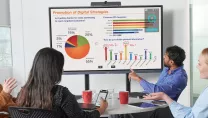Since the pandemic, chances are, there’s been much talk of Blended Learning within your school. But for those who aren’t familiar, it's a teaching approach that combines online and in-person learning to create a personalised and engaging learning experience for pupils. The best part? It's not just improving education for pupils, but for teachers too! In this blog, we'll explore the benefits of blended learning and provide tips on how to make it work for you.
What is Blended Learning?
Blended learning combines traditional teaching methods with online, remote, or home teaching and learning by utilising technology, enabling teachers to use a range of teaching strategies and techniques, including online resources, games, and quizzes. This approach to learning is proven to support whole-class inclusion by catering to the different learning styles and abilities of individual pupils. Moreover, blended learning allows for varied instruction, so teachers can provide additional support or challenges to pupils based on their learning needs.
What are the benefits of Blended Learning?
Blended learning doesn’t just benefit students - 73% of teachers say blended learning increases engagement. Adopting blended learning practices can also help schools save money by reducing the need for traditional teaching materials and hiring additional staff. Furthermore, blended learning classrooms save around £2,000 per student on average compared to the traditional models, and with up to 90% less energy is needed there are 85% fewer CO2 emissions per person. With the money saved by adopting blended learning schools can invest in technology such as laptops, tablets, and online resources that provide a more efficient and cost-effective approach to learning.
How does technology facilitate Blended Learning?
Now, you might be wondering how to make blended learning work for you. Well, technology is an essential tool for facilitating blended learning effectively. Let’s explore the practical benefits that blended learning can bring to your classroom.
Improving pupil’s experience
Interactive Screens can support blended learning, whether delivering lessons in class or remotely. Interactive screens are visualisers that provide teachers with the ability to share effortlessly with their pupils. So it doesn’t matter whether they’re teaching handwriting techniques, or showing brush strokes in an online art lesson, ultimately they can create an excellent format for engaging pupils and creating a more productive online lesson.
Getting everyone involved
The introduction of Microsoft teams in Education has revolutionised how pupils can work together and how teachers can deliver content. Whether it’s in the classroom or remotely, blended learning via tools like Microsoft Teams can positively influence and promote collaboration within schools by allowing team work to be conducted on a document simultaneously. Students can make notes and talk to each other using the chat function
too – so even those who may not always speak up in class can have their voices heard!
Implementing blended learning can also provide simpler solutions to giving pupils feedback. For example, using an LMS or “Learning Management System” means that teachers can directly feedback onto work completed online, without having to haul tonnes of books home at the end of the day for marking!
Safeguarding your pupils
Having a secure, manageable sign-in system for school has never been more important. A VMS provides full accounting for any visitors whilst ensuring the safeguarding of pupils and staff.
By implementing a Visitor Management System (VMS) in your school, you can streamline the sign-in process. Sign-in solutions such as Sharp’s VMS are the perfect way to help your school remain compliant and secure. Whether you’re a small primary school or a large multi-academy trust, implementing a piece of tech such as the VMS takes away what may have become a painstaking process of checking in visitors. For schools implementing blended learning, a reliable VMS provides staff with the ability to monitor which pupils are learning from home, which are on site, and which may have not attended due to sickness.
In conclusion, blended learning is both a cost effective and proven method of improving student and teacher performance that benefits everyone involved. By adopting blended learning practices, teachers can create a personalised and engaging learning experience for students and pupils, support whole-class inclusion, and save schools money in the long run. So, why not give it a try and see how blended learning can transform the way you learn and teach?
For more information around the technologies that can support your blended learning journey, get in touch





